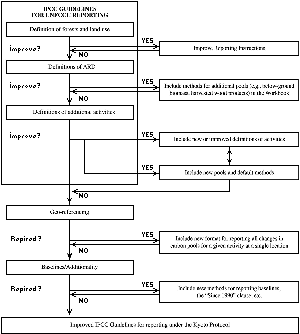|
6.5.2. Approaches for Improving the IPCC Guidelines

|
|
Figure 6-2: Decision tree for implementing
ARD and additional activities at the national level: implications for
the IPCC Guidelines.
|
Several articles in the Protocol (e.g., Articles 3, 5, 6, 7, and 12; UNFCCC,
1997) imply the need for more detailed reporting. If Parties decide that reporting
is to be different and more detailed for the Protocol, Article 5.2 of the Protocol
provides a mechanism for Parties to initiate a process to improve the methods
in the Guidelines.
Of importance in this context is a decision by the SBSTA at its eighth session
encouraging the IPCC Inventories Program to "give high priority to completing
its work on uncertainty, as well as to prepare a report on good practice in
inventory management.." In addition, the "SBSTA invited the IPCC to develop
a work plan addressing methodological issues raised in the IPCC special report
in the context of the IPCC 1996 Revised Guidelines for National Greenhouse Gas
Inventories in the areas of agriculture and land-use change and forestry, to
commence as soon as practicable following completion of the special report"
(FCCC, 1999). This work plan may include GPG in LUCF to be initiated in 2000.
A decision is required on what needs to be reported, and how, for each of the
Articles. This decision would facilitate further assessment of the possible
needs for further development of the Guidelines. Figure
6-2 illustrates a process for considering improvements to the Guidelines.
It would be helpful if improved guidelines were consistent with the existing
Guidelines to ensure compatibility with national reporting required under the
UNFCCC. Potential constraints on reporting are the availability and quality
of data, as well as the cost of generating and verifying this information. Furthermore,
the demands on technical capacity and infrastructure for data collection have
to be kept in mind, particularly for certain regions of the world.
Examples of several types of improvements are listed in Table
6-6. The time required for making such improvements will depend on the decisions
of the Parties. A crucial decision is how to deal with project reporting. Projects
are not currently covered by the Guidelines, and there are potentially more
issues at the project level to be considered than at the national level.
|
Table 6-6: Examples of possible modifications
to the IPCC Guidelines for reporting under the Protocol.
|
|
| Activity |
Changes Required to the Guidelines
|
Examples of Reporting
|
|
| Afforestation, reforestation, deforestation |
1. Definitions in the Reporting Instructions |
1. Changes in definitions of forest |
| 2. Reporting table |
2. Changes in C stocks for areas under ARD activities as a subset of national
inventory |
| 3. Worksheets and reporting table |
3. Methods to estimate data for 1990 at national level for ARD activities |
| 4. Accounting approach |
4. Augment carbon pools to include below-ground biomass, forest litter,
soil, and wood products |
| 5. Accounting approach |
5. Link changes in all carbon pools with geographically explicit information |
| 6. Accounting approach |
6. Adjust nonlinear rates of change in soil carbon appropriate to commitment
period |
| 7. Reporting table |
7. Transparent reporting of sampling method used, sample size, year or
periodicity of measurement, standard deviation, method of extrapolation |
|
| Additional activities |
1. Worksheets and reporting table |
1. Report explicitly additional activities such as sustainable forest
management, crop management, agroforestry, etc. |
| 2. Accounting approach |
2. Baselines |
| 3. Accounting approach |
3. Augment carbon pools to include below-ground biomass, forest litter,
and wood products |
| 4. Reporting table |
4. Track changes in areas of land use to avoid double-counting |
| 5. Reporting table |
5. Transparent reporting of sampling method used, sample size, year or
periodicity of measurement, standard deviation, method of extrapolation |
|
| Project activities |
1. Accounting method |
1. Baseline |
| 2. Accounting method |
2. Define and report boundary for the project and for reporting impacts
on off-site C stocks |
| 3. Accounting method |
3. Changes in C stocks due to leakage, positive spillover, and market
transformation (particularly off-site) |
| 4. Worksheet |
4. Changes in C stocks over commitment period and annually for assessing
permanence |
| 5. Reporting table |
5. Report method used, sample size, year or periodicity of measurement,
standard deviation, method of extrapolation |
| 6. Accounting approach |
6. Sustainable development |
|
|